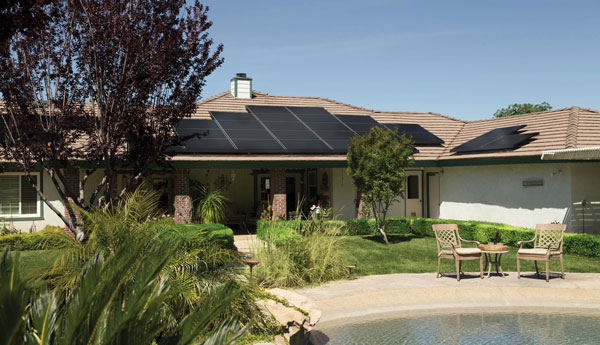
It’s no secret that one massive barrier to living off grid in this modern age, is how to power the numerous appliances that make our daily lives more convenient. To be sure, some who prefer a rural existence eschew these time-saving devices entirely, but for the vast majority of homesteaders it’s a serious concern. Fortunately, the world has progressed to the point that many solutions exist to what was, at one time, almost an insurmountable problem. From solar panels to efficient generators to lithium batteries, there’s little you can’t power off grid, so long as you keep your expectations reasonable. Read on for a basic idea on how a solar system works.
Solar Power
Solar panels have seen a surge of popularity in recent years, and it’s not hard to see why. With increases in their efficiency thanks to more modern materials, solar panels are now capable of generating so much energy that folks in sunnier parts of the country, like Arizona, have taken to selling excess power captured by their panels BACK to energy conglomerates. So how exactly does one of these systems work? Where, for instance, do you plug them in. Well, to start, you’ll need …
Panels
First, obviously, you’ll need solar panels, though the selection process is not quite as simplistic as it seems. Solar panels come in either 12-, 24- or 48-volt capacities. The higher the voltage, the easier it is for the system to produce and maintain energy. Most folks on small homesteads find 24 to be a good middle ground between cost and efficiency, though larger operations often use 48.
Combiner Box
Second, you’ll need a combiner box. For the first timer, I would recommend a prewired one. It will be more expensive, but save a helluva lot of headache. Instead of having to wire it yourself, you simply plug your panels into the provided sockets, and run cable out to the charge controller.
Charge Controller
Third is your charge controller. This is where research becomes more important (though to be sure, you should be researching brands for your panels and combiner box as well). This is because, for your charge controller, you need one with a higher voltage capacity than can be produced by your system. As your charge controller is the link in your system which keeps your batteries from overcharging (which will damage them), if you feed it more voltage than it can handle, it will itself be damaged.
Batteries
Fourth come the batteries. The best are far and away Absorbed Glass Matt (AGM) batteries, but they are EXPENSIVE. While they require more maintenance, go with regular Lead Acid batteries if you’re on a budget. As far as voltage goes, 24-volt batteries are common, particularly with AGMS, and provide an excellent option short of going with a full, 48-volt house system.
Inverter
Fifth and finally, to utilize all the power you’re making, you’ll need a DC to AC inverter. This will connect directly to your batteries and convert the Direct Current power stored there into Alternating Current you can use with your appliances. If this is going to be stored outside, or anywhere damp, make sure you get one with a ground fault circuit interrupter, so you don’t get electrocuted.
I hope you’ve enjoyed this basic primer. Tune in next week as we begin to break down the intricacies of each category above.
A humble homesteader based in an undisclosed location, Lars Drecker splits his time between tending his little slice of self-sustaining heaven, and bothering his neighbors to do his work for him. This is mainly the fault of a debilitating predilection for fishing, hunting, camping and all other things outdoors. When not engaged in any of the above activities, you can normally find him broken down on the side of the road, in some piece of junk he just “fixed-up.”

Lu says
What about EMP protection?
Can you imagine investing thousands of dollars in solar equipment and the sun, or an enemy nation attacks us with EMP?
Houses and vehicles don’t fit in a faraday cage!
Grumpy 49 says
Check out diysolarforum.com for general info on solar power. Costs are coming down, and systems are easy to build IF you pay attention to what you are doing. For long term or higher voltage systems, the new LiFePo4 batteries should be always be considered.
Check out websites, like Will Prowse’s diy solar power, for tutorials on DIY systems.
Donij1955 says
Thanks for the added info. It is appreciated!
James Phipps says
I think that you need to dig in with the ROI (RETURN ON INVESTMENT) with alternative power. If it is the only power solution like in the mountains, it’s a good option. However consider:
1. Capital investment
2. Installation
3. Maintenance costs of EVERYTHING
4. Life expectancy of the solar system
5. Weather damage from hail or wind or blowing debris
The ROI probably will exceed 5 years +.
George T says
Agreed. I have contemplated solar, but have hesitated because the ROI was sketchy. Battery life 5 yrs, inverter life 10 yrs and solar panels life 20 years give or take on each. At somewhere between $15,000 to $20,000 for a complete system in AZ the ROI does not look good to me.
I would like an article on the life expectancy of these components, a graph showing the efficiency decrease on the solar panels, the cost to replace each into the future and what form of maintenance is required.
For me I am not sold on solar. I have read numerous articles and the ROI is just not there.